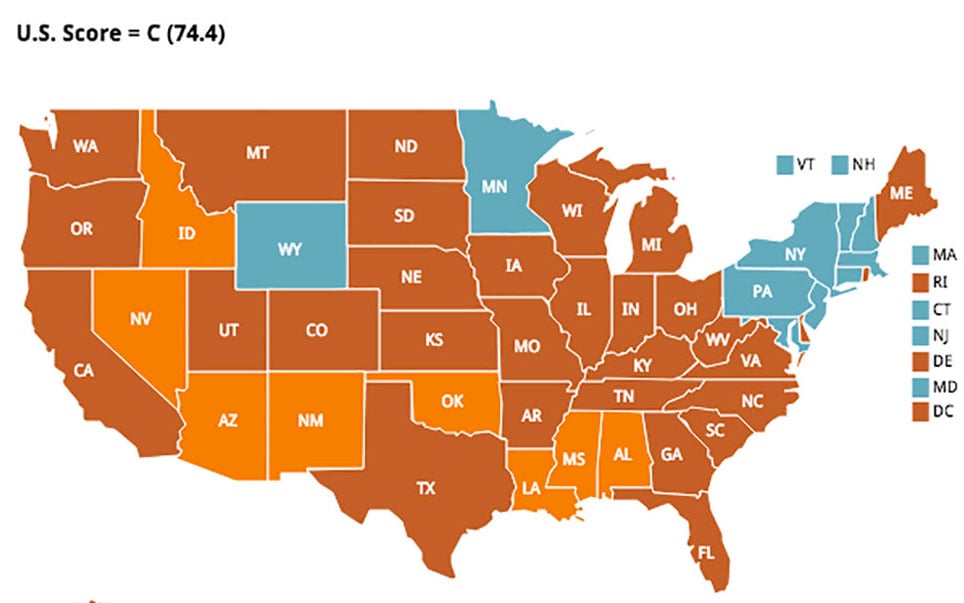
National average standardized test scores dipped from 2013 to 2015, while Arizona scores were level – but not enough to offset the state’s poor showing in school funding and student achievement gaps, a national report said. (Photo by albertog/flickr via Creative Commons)

Arizona moved from 47th place last year to 45th this year in the Education Week school rankings for states and the District of Columbia. But Arizona kept the overall D+ grade it earned last year. Blue states had higher grades, orange were lowest. (Map by Quality Counts 2016/Education Week)
WASHINGTON – Arizona student test scores stayed level from 2013 to 2015 while scores nationally declined slightly, but the state’s marginal gains were not enough to lift it out of the bottom ranks on a new national report card.
Arizona got a grade of D+ and was ranked 45th among states in the annual ranking by Education Week, which put the state’s level of school funding and its poverty achievement gap near the bottom in the nation.
The state’s poor performance in the Education Week report was cited last week by Arizona Superintendent of Public Instruction Diane Douglas in her State of Education address to the Arizona House Education Committee, saying it indicated a continual need for progress in education.
See related story:
Douglas: Arizona’s schools moving ‘one step closer’ to improvement
“It’s hard to really say we’ve improved that much,” said Charles Tack, an Arizona Department of Education spokesman. “It’s still a D-plus.”
Even though it was the second straight D+ for the state, Arizona did inch up from 47th place in last year’s report.
One element in the report is the National Assessment of Educational Progress, standardized tests that have been monitoring fourth- and eighth-grader proficiency in math and reading since the early ’90s.
Nationally, scores on average dipped from 2013 to 2015 in all areas except fourth-grade reading, which stayed the same. But Arizona’s math and reading scores saw no significant change between 2013 and 2015. Despite that, Arizona’s proficiency scores still landed around middle of the pack.
The report did note that Arizona had some of the nation’s highest NAEP gains between 2003 and 2015. But that was one of the few bright spots in the report, which also weighed school finances, chances for student success and K-12 achievement for all 50 states and the District of Columbia.
Arizona adjusted per pupil expenditures of $7,620 in 2013 ranked 50th, topping only Utah, which spent $6,980 per pupil, according to the report.
In 2014, a judge ordered the Arizona Legislature to pay schools $331 million for shorting districts on school funding during the recession. If constitutional amendment Proposition 123 is passed this May, $3.5 billion would be allocated toward schools over a 10-year period.
Melissa Lempke, spokeswoman for Expect More Arizona, said Prop 123 was a step in the right direction, but even if passed it still would not be enough.
Lempke said increasing funding for schools may not fix everything, but the current budget isn’t enough to implement effective educational changes. She said budget cuts have led to teacher layoffs, larger classrooms and the inability to update technology and textbooks.
Expect More Arizona surveyed voters in December and found that Arizonans cared more about education than immigration and the economy, she said.
“Unfortunately, it had to reach crisis level before people got fired up about it,” Lempke said.
Heidi Vega, a spokeswoman for the Arizona School Boards Association, emphasized in an email that the state has seen proficiency gains despite a lack in funding. “Imagine what our students, teachers and public schools could do if they were provided with the school funding they deserve?” she asked.
Although Vega said the state has narrowed the poverty achievement gap, Lempke said there is still a disparity across the state and among the districts, especially when it comes to funding.
Lempke said there are excellent educators and schools in the state, noting that three Arizona high schools were among U.S. News and World Report’s top 10 best high schools in the nation. But she said there is still a high achievement gap between minority and low-income students.
In her speech last week, Douglas said the report is “hardly cause to celebrate” but that there is “reason to be cautiously optimistic.” Tack echoed those sentiments.
“I think that shows what we’re doing here certainly needs work, we need to improve, but we’ve seen achievement gains,” he said.
“Each time we see something like this it’s a call to action for us,” he added later.